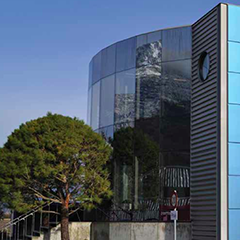Aesthetic limitations for PV have been a considerable barrier in implementing projects, but with few options, compromises have had to be made. Now, advances in technology are making PV glass a viable, and attractive alternative. PES speaks to SwissINSO’s Rafic Hanbali….
PES: Welcome to the magazine. Would you first like to introduce your company and explain how you serve the PV market?
Rafic Hanbali: SwissINSO is a pioneer in the development and application of new solar technologies. We wanted to create products targeted at enhancing the aesthetics and overall efficiency of building integrated solar energy solutions. And after ten years of research in partnership with EPFL (Swiss Polytechnic Institute), we developed a unique technology of coloured glass for solar applications. Kromatix technology offers the only attractive alternative to today’s black and dark blue panels, without compromising the panel efficiency. The result is inviting opaque (cells and captors cannot be seen) coloured solar panels with a mat finish and excellent performance. This revolutionary and patented Swiss technology represents a fundamental change in the integration of solar panels.
PES: Can you tell us a little more about the benefits of your Kromatix technology?
RH: Currently, much effort is used on trying to hide solar panels by installing them in less visible areas, such as on roofs of houses and buildings. Kromatix is the solution to integrate PV harmoniously and cover much wider areas, thus producing more energy. Relevant for new constructions, it can also be added to existing buildings. Non-active panels are available to enhance homogeneity of façades or roofs, ideal for places that do not receive enough light to produce energy. This technology was made for both thermal collector and PV panels. The building envelope can be improved to collect maximum solar energy.
We do not propose tinted glass or tinted cell. This kind of product loses a lot of efficiency and pigments generally deteriorate with light and temperature and therefore the colour loses intensity. Kromatix is a robust technology with a lifetime superior to that of the panel itself and the deterioration is almost non-existent. The new glass is available in blue, green, terracotta, grey and yellow for the time being.
PES: How does the solar transmittance differ from uncoated panels – indeed, is there any difference in the different colours you offer?
RH: The technology consists in the coating of interferential layers providing the colour. The colour is due to the reflection of a narrow spectral band in the visible part of the solar spectrum. It is what we see. Because of this reflection the panel efficiency slightly decreases. In comparison to panels equipped with normal extra-white glasses, solar panels equipped by such coloured glasses have relative energy losses of between 2 per cent and 8 per cent for photovoltaic modules and between 0.5 and 6 per cent for thermal collectors, depending on the chosen colour.
Nearly all colours are possible but, some of them are difficult to make or lose too much of the energy. Black and white are not colours. The first is already available (absent of colours) and the second is all colours. Making a white panel is equal to have a PV panel without efficiency. We cannot make panels in red either. So if you want a panel similar to this difficult colour, then the efficiency loss will be higher. For example, the orange loses about 8 per cent, meaning that a 225Wp panel will continue to produce around 207Wp. In comparison, the blue loses 4 per cent and the panel will produce 216Wp.




















